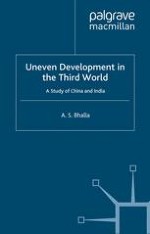1995 | Buch | 2. Auflage
Über dieses Buch
The book defines uneven development in terms of development strategies and their outcomes. Drawing on case-studies from China and India, three types of strategy are discussed: heavy industrialisation, sectoral/regional balance, and economic liberalisation. Also three kinds of outcomes are examined: growth of output and productivity, income, consumption and class inequalities in three spatial dimensions - intra-regional, inter-regional and rural-urban. Furthermore, access to and utilisation of technology, health and educational services are compared.
Anzeige
